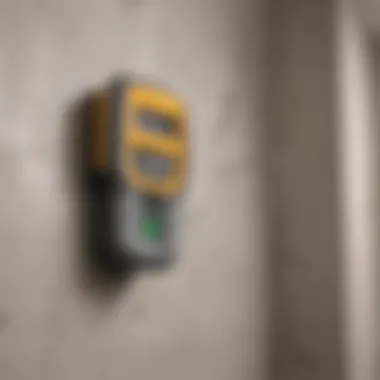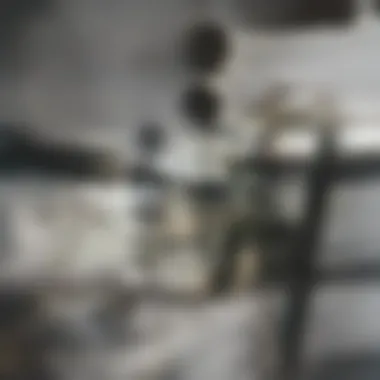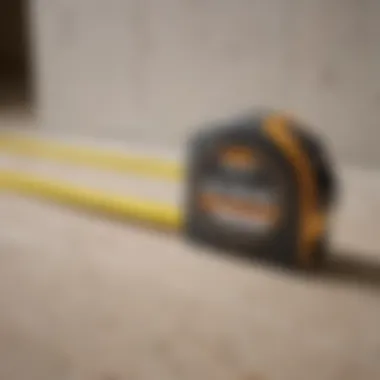Mastering the Art of Locating Drywall Studs


Intro
Locating studs behind drywall is a skill that can greatly enhance your DIY projects. Whether you plan to hang shelves, install cabinets, or mount a television, knowing the precise location of studs is essential. This guide delves into effective methods for identifying these structural elements, emphasizing accuracy and proper techniques. Understanding how to locate studs not only supports your projects but also helps avoid potential mishaps, like damaging electrical wires or plumbing.
Featured Homes
Architectural Styles
When discussing how to see studs through drywall, it is valuable to consider the various architectural styles where this knowledge becomes crucial. Homes built using traditional framing techniques often feature studs placed at standard intervals. Recognizing the characteristics of these structural designs can provide a clear guideline for detection methods.
For instance, in a colonial home, studs are typically 16 inches apart, a common practice in North American construction. This consistency aids in locating them without much complexity. Conversely, in modern architectural styles, such as open concept designs, the spacing might differ based on design preferences or structural requirements. This variability may require more careful measurements and techniques.
Unique Design Elements
In unique residential designs or historical homes, you may encounter irregular stud patterns. This is especially true in houses with additional architectural elements like arches, vaulted ceilings, or residential extensions. Understanding these variations is vital for accurate stud detection in such scenarios.
For example, in homes with reclaimed walls or vintage plasterwork, the hidden studs may not align with standard measurements. Having an adaptable approach and being aware of these exceptional features can help avoid frustrations during installation tasks.
Techniques for Locating Studs
Basic Methods
Several practical methods exist to find studs behind drywall. Among the simplest are:
- Knocking: Gently knock on the wall and listen. A hollow sound indicates spaces between the studs, while a solid sound indicates the location of a stud.
- Measuring: Start from a corner of the wall and measure. Most studs are arranged 16 or 24 inches apart, depending on the construction.
Using Tools
Various tools can enhance your stud-finding efforts:
- Stud Finders: Electronic stud finders and magnetic stud finders can simplify the detection process. Electronic stud finders are ideal for locating electrical wires.
- Level and Pencil: Use these tools to mark your measurements accurately while confirming your findings visually.
"A good stud-finding tool can save time and reduce the risk of costly mistakes."
Ending
In summary, the ability to locate studs behind drywall is a fundamental skill for anyone engaged in home improvement tasks. Identifying the spacing and structural elements of different architectural styles is pivotal for effective implementation. Mastering the methods and tools available ensures precise measurements and successful project outcomes.
Embrace the challenge and equip yourself with the knowledge to confidently tackle your next DIY project, ensuring both efficacy and safety.
Prolusion to Studs in Drywall
In any drywall installation or renovation, understanding how to locate studs is a fundamental skill. This knowledge is essential for anyone involved in home improvement, interior design, or even basic repairs. Studs provide the framework that supports drywall, and knowing their location can dictate how successfully other projects will be implemented, from installing shelves to hanging heavy objects.
Definition of Studs
Studs are vertical wooden or metal beams that form the underlying structure of walls. Typically spaced 16 or 24 inches apart, these structural elements are crucial for maintaining the integrity and strength of a wall. They support the weight of the installed materials, such as drywall and insulation, as well as any fixtures attached to the wall. Without proper identification of these studs, any drilling or nailing may risk damaging the wall or failing to secure items properly.
Purpose of Studs
The primary purpose of studs is to provide stable support for the drywall. This stability is essential, especially when it comes to hanging heavy frames, large television sets, or shelves. Moreover, studs facilitate the attachment of various electrical wiring or plumbing elements within the walls. Their strategic placement is designed not only for functional purposes but also to comply with building codes that ensure safety and durability in construction. By understanding what studs are and their role in wall construction, individuals can approach their home improvement projects with a more informed perspective. Proper stud identification allows for efficiency and precision, essential factors that can save time and reduce potential mishaps.
Importance of Locating Studs
Locating drywall studs is a pivotal skill in construction and renovation. Knowing where these supports are located can significantly affect the safety and integrity of any project. Observing precision in stud detection not only enhances the reliability of securing items but also mitigates risks associated with accidents or damage.
Using studs as anchoring points provides enhanced strength in applications such as hanging furniture or mounting televisions. This positioning ensures that the objects rest on solid framework rather than just the drywall itself. Uneven weight distribution can lead to failure and potential injuries, emphasizing the necessity for reliable methods in detecting these structural components.
"Studs are the backbone of drywall installations, offering crucial support for various fixtures and equipment."
Moreover, understanding the spacing of studs aids in planning renovations. Commercial structures and residential homes generally adhere to specific spacing measurements, typically 16 or 24 inches on center. This knowledge aids in layout design when installing shelves or cabinets, helping prevent costly miscalculations that could result in the need for additional materials or labor.
Safety Considerations
Identifying the location of studs before drilling or nailing into walls is essential for safety. Missing a stud may lead to hitting wires or plumbing. These hidden utilities can create dangerous situations, including electrical hazards or water damage. Taking the time to locate studs ensures a clear understanding of the wall structure and avoids unpleasant surprises.
In addition, securely anchoring items to studs minimizes the risk of objects falling. For example, a poorly hung heavy mirror or shelf can cause injuries or damage if it dislodges from the wall. Properly locating studs eliminates such dangers by ensuring that heavy items are enveloped in the wall's framework.
Practical Applications
The applications of locating studs are numerous and important. Here are some common scenarios where accurate stud detection plays a vital role:
- Hanging Heavy Objects: Items like televisions, large artworks, or shelves require solid anchoring into the stud. This provides a reliable hold, reducing the risk of falls.
- Building or Renovating: Knowing stud locations aids in the construction or renovation process. It allows for more straightforward installation of materials like drywall, insulation, or soundproofing products that must be secured to framing.
- Installing Fixtures: Anything from cabinets to bathroom fixtures hinges on knowing stud placement. Accurate stud detection assures that fixtures are stable and can support daily use.
- Avoiding Damage: Misplacing holes in drywall can lead to additional repairs and unexpected costs. Locating studs reduces waste and preserves the integrity of the wall.
Each method outlined for locating studs serves to streamline the process of home improvement projects while enhancing overall safety and functionality.
Traditional Methods for Finding Studs
Understanding traditional methods for finding studs is essential for anyone engaging in home renovation or improvement projects. These techniques, while simple, are often highly effective. They offer a practical approach to determining stud location without the need for advanced tools. Learning these methods can save both time and money, and they serve as a good foundation for using more modern tools later.
Using a Measuring Tape
Using a measuring tape is one of the oldest methods for locating studs within drywall. It is based on typical stud spacing, which is usually either 16 or 24 inches apart. To utilize this method, one should begin measuring from a corner of the wall or from an electrical outlet. Most outlets are attached to the side of a stud. If you start measuring in 16-inch increments, it can guide you to the stud locations. This method is not foolproof, but it’s straightforward and effective if the wall framing adheres to these common spacings.
- Measure from the corner or outlet: Start at a fixed point on the wall.
- Make marks at intervals: Use marks every 16 or 24 inches to predict stud locations.
- Knock to verify: After marking, use the knocking method to confirm the actual location of the stud.
Testing this method can yield results but be aware it does depend on the original construction standards being followed. Non-standard spacing can reduce its efficacy.


Knocking Technique
The knocking technique is another tried-and-true method for finding studs. To use this method, simply knock on the drywall with your knuckles while moving horizontally across the wall.
As you knock, listen for differences in sound. A hollow sound usually indicates the space between studs, while a solid sound typically signals that you have located a stud. This approach requires a bit of practice to distinguish the subtle variations in sound.
- Start at one point of the wall: Begin knocking and listen carefully.
- Move slowly: Shift horizontally to detect changes in sound as you go.
- Mark the location: When you identify a solid sound, mark the area to confirm your findings later.
"The knocking technique relies heavily on auditory perception and can be surprisingly effective in identifying stud locations."
Modern Tools for Stud Detection
In the realm of home improvement, modern tools for stud detection have revolutionized how individuals approach the task of finding studs behind drywall. Traditional methods can often lead to inaccuracies or an increased risk of damaging underlying structures. This makes investing in the right modern tools not just a convenience, but a necessity for anyone looking to mitigate risks and ensure a precise outcome.
Modern stud detection tools come with several benefits that make them invaluable. They often reduce the margin for error significantly. Accuracy in measurements is critical when positioning certain items, such as heavy shelves or artwork. Moreover, these tools are designed to minimize the chances of damaging the wall, a common concern during renovations. The role of technology in stud detection aids not only amateur DIY enthusiasts but also seasoned professionals. Hence, understanding the two main categories of modern stud detectors—stud finders and electronic devices—is paramount, as each serves distinct functions that cater to different needs.
Stud Finders
Stud finders have become a staple in the toolbox of modern home improvement projects. They are versatile devices that use various technologies to detect the presence of wooden or metal studs behind drywall. These tools can be broadly categorized into two types: magnetic and electronic stud finders.
- Magnetic Stud Finders: These devices use magnets to locate nails or screws embedded in studs. They are generally less expensive and simple to use. However, their reliability might decrease in instances where the fasteners are not in the expected position.
- Electronic Stud Finders: On the other hand, electronic stud finders utilize sensors to detect changes in density behind the wall. This allows them to provide more accurate readings. They usually come equipped with additional features, including audio alerts to indicate the location of the stud.
Using a stud finder requires an understanding of its calibration procedures and reading its signals. Calibration ensures that the tool functions accurately in varying conditions, while learning to interpret the signals can further enhance the effectiveness of the device.
Electronic Devices
Beyond standard stud finders, electronic devices represent a significant advancement in the field of stud detection. These tools provide highly accurate readings and often come with features that enhance their utility. For example, some devices can detect live electrical wires and pipes, providing safety warnings that are crucial during any renovation.
- Multi-Functionality: Many electronic devices combine stud detection capabilities with other functions. This means that one tool can help locate studs and also identify various hidden elements within the wall.
- Smart Technology: New models may even connect to smartphones or tablets to log data and potentially enhance the finding process. This could be beneficial for professionals managing multiple projects simultaneously.
When considering which electronic device to use, factors such as battery life, ease of use, and specific features become important. Individuals should evaluate their project needs to select the most appropriate tool.
"Utilizing modern tools for stud detection can lead to more successful home improvement projects by ensuring accuracy and safety."
Types of Stud Finders
Understanding the various types of stud finders is crucial for anyone involved in home improvement projects. Each type offers distinct advantages and may be better suited for particular situations. Selecting the right stud finder can significantly affect the success of your project, ensuring that you locate studs accurately without damaging the wall.
Magnetic Stud Finders
Magnetic stud finders operate using a simple yet effective principle. They detect nails or screws embedded in the drywall, which means they can find studs indirectly by locating the metal components used in construction. This type is usually lightweight and easy to use, making it an excellent choice for DIY enthusiasts.
Benefits of Magnetic Stud Finders:
- They are typically inexpensive compared to electronic models.
- No need for batteries, as they function purely on magnetic attraction.
- Suitable for various wall types.
Considerations:
While magnetic stud finders are useful, they may not detect the center of the stud. Instead, they often find the edge of it. This limitation means you may need to take additional steps to confirm the exact position of the stud before drilling or anchoring anything.
Beam-Detection Stud Finders
Beam-detection stud finders employ a more advanced technology compared to magnetic models. These devices can identify the density changes in the wall material, thereby detecting studs more accurately. Some models are equipped with digital displays, providing visual confirmation of stud location.
Advantages of Beam-Detection Stud Finders:
- Capable of locating both wood and metal studs effectively.
- Often provide detailed information about the wall structure, including depth detection.
- Many models support the identification of other features, like electrical wires.
Considerations:
While beam-detection stud finders offer superior accuracy, they typically come at a higher price point. It is also essential to ensure the device is calibrated properly before use to avoid misleading results.
Choosing the right stud finder based on the specific task can lead to greater ease and efficiency in your home improvement projects. Select wisely to enhance your DIY abilities.
In summary, familiarity with magnetic and beam-detection stud finders equips you with the knowledge to select the tool that best fits your project needs. Understanding their advantages and limitations can help you make informed choices, leading to successful outcomes.
Best Practices for Using Stud Finders
Using stud finders effectively requires a blend of knowledge and technique. Following best practices can significantly improve accuracy in locating studs, ensuring that home improvement projects such as hanging shelves or installing artwork are both successful and secure. The importance of thoroughness cannot be overstated in this process, as even minor errors in locating studs can lead to failed installations or damage to walls.
Calibration Procedures
Calibration is a critical first step in using stud finders and is not always intuitive. Most electronic stud finders require a calibration step before each use to ensure that they deliver accurate readings. This usually involves holding the device against the wall and pressing a button to set it to the current wall position.
Here are some key points for calibration procedures:
- Sensor Check: Make sure the sensors are clean and free from debris. Dust can interfere with readings.
- Consistent Surface: Ensure that the wall surface is relatively even, as bumps can cause inconsistent readings.
- Follow Manufacturer Instructions: Always refer to the specific stud finder’s manual for calibration steps, as different models may have varied requirements.
Reading the Signals
Understanding how to interpret the signals from a stud finder is essential. When using the device, it will typically light up or sound an alert when it detects a change in density within the wall. This change usually indicates a stud location.
Consider these factors when reading the signals:
- Multiple Signals: If your device beeps or lights up multiple times in one area, it could indicate more than one stud or other framing materials.
- Movement: When detecting signals, move the device slowly and steadily across the wall. Quick movements may lead to false readings.
- Check Beyond Initial Readings: Once a stud is identified, it’s advisable to double-check the area by moving the finder horizontally to confirm the width of the stud.
"Measuring correctly and using calibrated devices can save time and prevent costly mistakes in home projects."
By incorporating these best practices, users can enhance their stud-finding proficiency, reducing frustration during projects and increasing overall success.
Visual Identification of Studs
Visual identification of studs is a key technique when it comes to understanding how to locate them effectively behind drywall. This method is advantageous because it relies on observable signs rather than only utilizing tools. The benefits of using visual identification include saving time and increasing accuracy. By recognizing physical indicators, one can confirm stud positions even if electronic devices fail. Some of the considerations include the experience level of the individual, the condition of the wall, and the type of studs used in the wall structure.


Looking for Nail Pops
Nail pops are small, raised bumps on the drywall surface. They occur when nails used to attach the drywall to the studs work their way slightly out of the surface. By looking for nail pops, one can easily identify stud locations. Typically, these pops indicate where nails are present, which correlates with the underlying studs. While this method can be very effective, it is important to note that not every stud will have a visible nail pop, especially in newer homes where screws may have been used instead of nails.
Stud Layout Patterns
Understanding stud layout patterns can greatly enhance the effectiveness of stud detection. Most residential walls follow standard spacing, but variations do exist. Recognizing these patterns helps in predicting stud locations without additional tools.
16-inch Center Spacing
The 16-inch center spacing is a widely accepted standard in residential construction. This means that the distance between the centers of two adjacent studs is typically 16 inches apart. The significance of this standard lies in its frequency of use. Many construction practices follow this rule to ensure structural integrity.
A key characteristic of the 16-inch center spacing is that it allows for easier attachment of elements like shelves and cabinets. The spacing offers ample support for weight-bearing installations. A unique feature is that when measuring from one stud to another, the width of the stud is considered part of this measurement. One of the advantages of this spacing is consistency, which simplifies the location process for the do-it-yourself enthusiast.
24-inch Center Spacing
24-inch center spacing is another common layout seen in construction. This layout is particularly favored in situations that do not require as much load-bearing support, like certain types of drywall applications.
A key characteristic of the 24-inch center spacing is reduced lumber usage, which can be cost-effective for builders. This spacing can pose challenges, however, as it may reduce the ease with which one can mount objects securely to drywall. Unlike the 16-inch spacing, this method can lead to fewer attachment points for heavier items, making it a less optimal choice for hanging significant loads.
Using visual identification techniques, such as recognizing nail pops and understanding stud layout patterns, can greatly enhance the overall efficiency in locating studs.
Methods for Confirming Stud Location
Confirming the location of drywall studs is essential for any construction or home improvement task. Accurate identification ensures safety, efficiency, and a clean finish, especially when heavy objects or fixtures are involved. The following methods serve as practical approaches to verify stud placement, helping to prevent mistakes that could lead to damage or instability.
Drilling Test Holes
Drilling test holes is a straightforward and effective method for confirming stud locations. This technique involves drilling small, shallow holes in the drywall to verify whether a stud is present. While this method is highly accurate, it can also be slightly invasive, so careful consideration is necessary.
When utilizing this method:
- Choose the drill bit size: A smaller bit is preferable to minimize the damage to drywall. Typically, a 1/4-inch bit suffices.
- Start where you believe the stud to be: Based on previous measurements or techniques, select an area and drill a hole.
- Assess the findings: If you encounter resistance, you have likely hit a stud. If the drill enters easily, proceed with additional measurements to confirm stud positions.
This method is often used by professionals who require certainty about where to place fasteners, especially during installations of heavy items like cabinetry. However, one must always factor in potential issues with finishing the holes afterward.
Using a Level
Using a level offers another practical method for confirming studs' locations. This tool helps in aligning and finding hidden studs through visual cues.
To use a level for this purpose, follow these steps:
- Locate a known stud: Identify one stud using a previously established method like a stud finder or manual techniques. Mark its location on the drywall.
- Set the level horizontally or vertically: Place the level against the wall with the bubble centered.
- Look for a consistent rise or dip in the level: If the drywall is not flat or if the bubble moves away from the center as you adjust the level, it may indicate the presence of additional studs nearby.
Using a level can enhance the accuracy of your work and provides a way to ensure that all installations are correctly aligned. This method is especially useful for identifying patterns in stud layouts, as they might not be placed consistently throughout the wall.
Finding studs through confirmed methods like drilling test holes and using a level can transform your approach to wall projects. These techniques ensure professional-grade results with higher reliability.
In summary, confirming stud location through practical methods minimizes risks associated with installation errors. Both drilling test holes and utilizing a level can provide clarity in locating drywall studs, enhancing the overall effectiveness of any home improvement endeavor.
Potential Challenges in Finding Studs
Finding studs behind drywall is a crucial step for various home improvement projects. However, it is not without its challenges. Understanding these challenges can save time and prevent mistakes. This section addresses the difficulties that can arise when locating studs, focusing on non-standard spacing and the existence of obstructions and utilities. Each challenge is significant when it comes to ensuring proper placement and avoiding damage.
Non-Standard Spacing
In traditional wall framing, studs are usually spaced either 16 or 24 inches apart. However, in many cases, this standard is not followed. Builders may choose non-standard spacing for various reasons, such as design preferences or structural needs. This non-conformity can lead to confusion when locating studs.
When working with irregular spacing, it is essential to rely on precise methods. While traditional measurements may serve as a guide, they can lead to errors during installation. It is advisable to check for stud locations using multiple techniques to confirm findings. Relying on only one method could result in missing the stud entirely, leading to an insecure mounting.
Obstructions and Utilities
Another significant challenge when finding studs is the presence of obstructions like electrical wiring or plumbing. These elements are often hidden behind walls and can create complications in locating a stud accurately.
When drilling or nailing into a wall, one must first consider what lies behind the drywall. Hitting a water pipe or electrical cable can cause damage and, more seriously, create safety hazards.
To avoid these risks, it is advisable to use both a stud finder and a utility locator tool when working in walls that may contain hidden obstructions. This dual-approach helps ensure safety and can outline a more accurate depiction of where the studs and utilities are positioned.
It is prudent to always tread carefully when modifying walls. Understanding what lies beneath can protect both your project and your personal safety.
In summary, potential challenges in finding studs are crucial to examine. Non-standard spacing and hidden obstructions emphasize the need for careful planning and evaluation. By being aware of these issues, one can approach home improvement projects with greater confidence.
Dealing with Drywall Variations
When working on drywall, recognizing variations is essential. This knowledge impacts how one locates studs effectively and ensures successful installation of various fixtures. The importance of understanding drywall variations cannot be understated. It affects not only the ease of detection but also the sturdiness of what one plans to hang on the wall.
Different Drywall Thicknesses
Drywall comes in various thicknesses, most commonly 1/2 inch and 5/8 inch. Knowing the thickness is crucial for several reasons. Using the correct stud finder or technique may depend on the depth you need to penetrate to locate the stud.
A standard stud usually sits directly behind the drywall, but thicker drywall can obscure the signal of some stud finders. Thicker drywall also requires longer screws for installation of items like shelves or mounted TVs.
Here’s a quick overview:
- 1/2 inch drywall: Commonly used for residential interiors, it is lighter and easier to handle.
- 5/8 inch drywall: Often preferred for ceilings or areas requiring fire resistance, it is denser and provides better soundproofing.
Types of Drywall Materials
Drywall materials vary not just in thickness but also in composition. Understanding different types can aid in knowing how to best locate and secure studs.
- Regular drywall: The most common type, made from gypsum plaster sandwiched between layers of paper. It’s suitable for many indoor applications.
- Moisture-resistant drywall: Often called green board, it is used in areas exposed to humidity, like bathrooms and kitchens. It has a coating that makes it impervious to moisture absorption.
- Fire-resistant drywall: Made with a core that has special additives, making it suitable for fire-rated walls. This type requires different fasteners and may lead to varied stud locations.
- Soundproof drywall: Designed to reduce sound transmission, this type can be thicker and denser, which affects how easily one can detect studs behind it.


Understanding the specific type of drywall can improve accuracy in stud locating techniques and ensure safe installations.
Recognizing these variations can lead to more successful home improvement projects. Adjusting approaches based on materials and thickness can eliminate common pitfalls and improve overall effectiveness in working with drywall.
Understanding Wall Construction
Understanding wall construction is essential for accurately locating drywall studs. This knowledge aids in recognizing how walls are built, and the implications of those designs when searching for studs. When embarking on home improvement projects, comprehending the structure of walls enables better decision-making and more effective use of tools and techniques for stud detection.
Framing Structures
Framing structures represent the backbone of wall construction. Typically, these frames consist of vertical studs, horizontal plates, and diagonal bracing, forming a strong structure that supports the dwelling. The framing not only provides stability but also establishes the locations of the studs, which are generally spaced at regular intervals.
When locating studs, it is vital to note that most building codes stipulate a standard stud spacing of either 16 or 24 inches on center. This means that from the center of one stud to the center of the next, there should be a consistent distance based upon these measurements. By understanding these patterns, individuals can estimate stud locations, which simplifies the process of marking or drilling into the drywall.
Insulation Types
Insulation types present another layer of complexity in wall construction. Insulation is often inserted between studs to provide thermal resistance and enhance energy efficiency. The presence of insulation can affect stud detection methods, especially if a material has unique characteristics or is installed incorrectly.
Common insulation materials include fiberglass batts, cellulose, and spray foam. Each of these materials has different density and appearance, which can influence how signals are transmitted if using an electronic stud finder. For instance, thicker insulating layers can sometimes give false readings or obscure the actual location of the studs.
Being aware of the insulation types and their placements assists in identifying potential challenges when locating studs, allowing for better planning and preparation during renovation projects.
Understanding wall construction and its elements is a crucial step in effectively seeing studs through drywall. Armed with this knowledge, home enthusiasts can approach their projects with confidence.
Practical Applications in Home Improvement
Identifying drywall studs is an essential skill for any home improvement enthusiast. Understanding practical applications in home improvement means knowing how to leverage stud location for various tasks. Accurate stud detection not only enhances safety but also ensures the effectiveness of installations. Whether hanging heavy objects or mounting shelves, comprehending how to locate these structural elements can make a significant difference in the outcome of a project.
Using studs as anchoring points is crucial when dealing with heavy items. For instance, when one considers hanging a large mirror or a flat-screen TV, securing the brackets into a stud prevents the risk of falling. It is important to note that drywall alone cannot bear significant weight. Therefore, it is wise to always aim for a stud when installing anything that exceeds a few pounds. Consideration for stud placement will ultimately influence both the aesthetics and functionality of your space.
Locating studs is not just about hanging; it is about ensuring safety and long-term satisfaction with your projects.
Hanging Heavy Objects
When hanging heavy items like televisions or cabinets, proper stud detection is vital. Standard drywall panels can only support limited weight. If you hang a heavy item directly on drywall without securing it to a stud, it can lead to damage or complete failure of the mount. You must identify the studs before installation.
Several methods are effective in locating studs to ensure secure placements:
- Stud finders can accurately indicate stud positions.
- Knocking technique helps in determining sound differences when hitting drywall.
Moreover, when using screws or brackets, you should choose proper hardware that matches the weight of the object. Larger screws with sufficient length will penetrate deeper, engaging more of the wood within the stud. Proper techniques will safeguard your installation.
Installing Shelves
Installing shelves can enhance both storage and aesthetic appeal in a home. For stability, these shelves must be fastened to studs. It is crucial to verify their location before proceeding.
Consider the following aspects when installing shelves:
- Weight capacity: Light shelves can be secured directly to drywall, but heavier shelves should be installed into studs.
- Spacing and height: Understand the shelving requirements based on what you plan to store.
- Hardware selection: Use brackets designed for the weight they will hold.
The right approach guarantees that installed shelves can support their intended loads while appearing visually appealing. Missing the studs or using improper anchoring can create future issues, including sagging or collapse.
In summary, effectively locating studs lays the foundation for successful home improvement projects. This skill fosters confidence and enhances the functionality and safety of installations. Whether hanging heavy objects or installing shelves, proper stud identification is a cornerstone of quality workmanship.
Common Mistakes to Avoid
Identifying studs through drywall is essential for successful home improvement tasks. However, many individuals, whether proficient in DIY or novices, often make common mistakes that can hinder their efforts. This section outlines these blunders to help readers avoid pitfalls and enhance their understanding of stud detection.
Misreading Stud Finder Results
Stud finders are widely used tools for locating studs behind drywall. While they can be very useful, improper interpretation of their signals can lead to errors. One frequent mistake is assuming that all readings from the stud finder are accurate, even when they may indicate something different. For example, some devices may show inconsistent signals when they come close to electrical wires or metal plumbing.
It's crucial to understand the specific type of stud finder in use and its functionalities. Some models might require calibration or resetting before actual use. Additionally, the user should not solely rely on the signals for accurate stud placement. Taking a second measurement at different spots can confirm the find.
"Relying on a single reading can lead to costly mistakes, resulting in damaged walls or misaligned fixtures."
To mitigate misreading issues:
- Check the settings: Ensure the finder is set properly for the material type and depth of the studs.
- Conduct multiple scans: It's wise to scan different areas before concluding the stud's location.
- Correlate findings with physical indicators: Use visual signs like nail pops or screw heads to cross-check findings.
Inaccurate Measurements
Another common error is taking measurements that are illogical or erroneous. When hanging objects, many assume that studs are spaced uniformly, ignoring the possibility of variations. While studs are typically found 16 or 24 inches apart on centers, older homes or renovations may not follow this standard. Not measuring correctly can result in drilling in the wrong location, compromising wall integrity and wasting materials.
Taking precise measurements involves several steps:
- Find the first stud accurately: Starting from one corner of the wall can help locate the first stud.
- Measure systematically: Most studs are set off at 16 or 24 inches. Make precise calculations based on where the first stud is located.
- Use a measuring tape: This traditional tool remains one of the best resources for ensuring accuracy.
Keeping the measuring process systematic and meticulous not only enhances precision but also minimizes the risk of mistakes related to misalignment.
Understanding these common missteps assists in refining stud detection techniques and enhances the quality of home improvement projects.
End
In the context of home improvement and renovations, the ability to see studs through drywall is fundamental. This article has outlined various effective strategies and tools to achieve this, emphasizing the need for precision in identifying these structural elements.
Summary of Techniques
The approaches discussed include both traditional and modern methods for stud detection. Using a measuring tape or the knocking technique serves as a classic method, while stud finders and electronic devices provide a more advanced solution. These techniques are not merely academic; they have practical applications in many home projects. Here are some key takeaways:
- Traditional Methods: Knocking on the wall and listening for differences in sound can give clues to stud location, along with measuring from recognized points on the wall.
- Modern Tools: The use of magnetic and beam-detection stud finders streamlines this process and enhances accuracy, reducing the risk of damaging underlying systems like electrical wiring.
- Best Practices: Calibration of tools and understanding their signals can significantly increase the chances of locating studs correctly. Simple tasks, such as marking the wall, can be invaluable.
Final Thoughts on Stud Detection
Ultimately, the knowledge gained about detecting studs through drywall is applicable not just in the realm of DIY but also critical for professionals. Understanding the construction of walls and the layout of studs paves the way for successful installations. This will ensure that objects are hung securely and avoid potential issues like hitting pipes or wires. The practical methods discussed can lend confidence to anyone undertaking a home improvement project, reinforcing the idea that knowing how to find studs is an essential skill. Developing proficiency in stud detection can transform the way one approaches renovations, making it a vital topic for any homeowner or builder.















